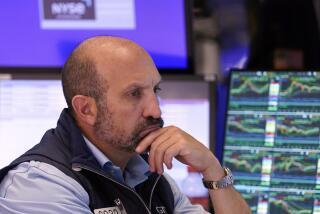FINANCIAL MARKETS : Stocks Sell Off as Rally Fails; Dow Loses 18
NEW YORK — Profit taking pulled stock prices lower Tuesday as waves of program selling hit a market vulnerable to a selloff in light trading following the Memorial Day holiday.
The Dow Jones index of 30 industrials ended down 18.22 points at 2,475.55--its biggest one-day loss in a week--after fluctuating throughout the session.
The closely watched index, which closed up 11 points on Friday, had risen nearly 17 points after the opening bell Tuesday and was off as much as 35 points in late afternoon.
In the broader market, about five stocks declined for every three that rose on the New York Stock Exchange, with 917 down, 559 up and 490 unchanged.
Volume on the Big Board came to 151.78 million shares, up slightly from 143.12 million Friday.
Several waves of futures-related selling, triggered by a decline in bond prices, sent Wall Street into an afternoon slump, pulling the Dow index nearly 30 points lower before prices began to recover in late trading.
The computer-driven selling undercut a thin market in the first day of trading after Monday’s Memorial Day holiday, when U.S. financial markets were closed.
Some analysts said Tuesday’s selloff was expected as investors reevaluated the direction of the market after its sharp run-up of recent weeks.
“The fever in the market was picking up,” said Alfred Goldman, a vice president for A. G. Edwards & Sons Inc. “But its rosy cheeks may not be the glow of health.”
Analysts said a gradual change in the direction of rates, profit taking and worries about the long-term effects of a rising dollar on the economy took their toll on the market.
Investors were particularly concerned about whether the dollar’s strength in foreign exchange, which continued Tuesday, could hurt the U.S. economy sensitive to trade, analysts said.
“The stock market is not responding to the stronger dollar and good bond market the way it did in prior weeks,” said Hugh Johnson, senior vice president for First Albany Corp.
Facilitating the market’s decline was a rash of selling by professional traders engaged in computer-program strategies involving options and futures on stock indexes, analysts said.
Among the most actively traded blue chip stocks, Texaco was up 1/2 to 51 1/2; American Telephone & Telegraph was down 1/8 to 35 5/8; International Business Machines was down 1 1/4 to 108 1/4; General Electric was down 1/4 to 54.
Time jumped 3 to 135 amid continued speculation that another bidder could emerge and derail a proposed merger with Warner Communications.
On the Tokyo Stock Exchange, shares closed down in light trading, with investors generally sidelined watching the dollar for signs that it was ending its climb against the yen. The 225-share Nikkei average slipped 83.94 points to close at 34,076.89.
Share prices also closed lower Tuesday on the London Stock Exchange, as the slumping pound fueled fears of more interest rate hikes. The Financial Times 100-share index fell 10.3 points, or 0.5%, to 2,130.0.
Commodities
Cocoa futures prices plunged following a report that the Ivory Coast, the world’s largest cocoa producer, will cut by almost 40% the prices it pays farmers for the crop.
The strong U.S. dollar, which also contributed to the drop in cocoa futures, helped depress grain and soybean futures and contributed to a mixed performance by precious metal futures.
On other markets, frozen pork bellies turned sharply lower because of rising inventories and petroleum futures were mixed.
The July cocoa contract on the New York Coffee, Sugar & Cocoa Exchange settled $79 lower at $1,141 a ton, with deferred months showing drops ranging from $26 to $49 a ton.
“Cocoa may have ended off the day’s lows only because of some late short-covering,” said Kim Badenhop of Merrill Lynch Capital Markets Inc. in New York. “It was plummeting for a while.”
According to projections, the Ivory Coast will sell an estimated 685,000 tons of cocoa this year, compared with 385,000 tons for Brazil, the world’s No. 2 marketer, and its producers already are the highest paid in Africa.
Analysts had been anticipating that Ivory Coast President Felix Houphouet-Boigny would announce a cut in the producer prices soon to save government funds and ease overproduction.
Reports that Houphouet-Boigny would announce the cuts--from about $1,190 per ton to $744--later this week apparently originated with remarks to that effect by a World Bank official Tuesday in Washington.
The U.S. dollar’s continued rally in foreign exchange helped nudge prices lower because significant amounts of cocoa are bought and sold on the London Mercantile Exchange and the dollar improved its position relative to the British pound.
The stronger dollar--which makes U.S. exports more expensive--also helped depress the grain markets on the Chicago Board of Trade, although the principal market feature was weather, analysts said. Grain and soybean futures prices closed lower nearly across the board.
Traders said wet weather that touched key growing areas over the three-day holiday weekend and forecasts calling for more of the same helped push prices lower.
Wheat settled 3.50 cents lower to 1 cent higher, with July at $3.91 a bushel; corn was 2.50 cents to 6.50 cents lower, with July at $2.6175 a bushel; oats were 3.50 cents to 4.75 cents lower, with July at $1.6525 cents a bushel; soybeans were 6 cents higher to 19 cents lower, with July at $7.18 a bushel.
Frozen pork bellies were 1 cent to 1.6 cents lower, with July at 29.47 cents a pound; live hogs were 0.33 cent to 0.95 cent lower, with June at 47.27 cents a pound; live cattle were 0.55 cent lower to 0.28 cent higher, with June at 68.70 cents a pound, and feeder cattle were 0.52 cent to 0.70 cent lower, with August at 76.52 cents a pound.
Crude oil traded on the New York Mercantile Exchange was 16 cents lower to 43 cents higher, with July at $19.95 a barrel; heating oil was 5 cents to 25 cents lower, with June at 49.15 cents a gallon.
Credit
Bond prices closed mixed, with long-term issues slipping while shorter-term bonds rose, after tracking the dollar for much of the session.
The Treasury’s bellwether 30-year bond slipped 5/32 point, or more than $1.50 for every $1,000 in face value. Its yield, which moves in the opposite direction from price, edged up to 8.62% from 8.61% late Friday.
Bond prices were higher for much of the day but turned lower in late trading as the dollar slipped, said Maury Harris, chief economist with Paine Webber.
The dollar ended the day on the plus side against major foreign currencies, but off from its highs of the day.
Harris said bond traders had also expected the Federal Reserve to ease credit through its open market activities Tuesday, but when it became apparent the Fed was not going to act, some bondholders seized the opportunity to take profits.
When the Fed eases credit, interest rates slip, sending bond prices higher.
The federal funds rate, the interest on overnight loans between banks, was quoted at 9.75%, up slightly from 9.633% Friday.
Tables begin on Page 8
More to Read
Inside the business of entertainment
The Wide Shot brings you news, analysis and insights on everything from streaming wars to production — and what it all means for the future.
You may occasionally receive promotional content from the Los Angeles Times.










